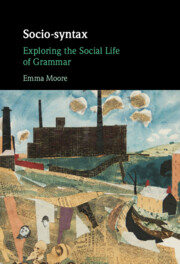Book contents
- Socio-syntax
- Socio-syntax
- Copyright page
- Dedication
- Contents
- Figures
- Tables
- Acknowledgements
- 1 Why Does the Social Meaning of Grammar Matter?
- 2 The Social Landscape of Midlan High
- 3 How Do We Study the Social Meaning of Grammatical Variation?
- 4 How Free Are We to Vary the Grammar We Use?
- 5 How Do We Use Grammar to Design Our Talk?
- 6 Does Everyone Use Grammar to Make Social Meaning?
- 7 How Does Grammar Combine with Other Elements of Language?
- 8 What Does It Mean to View Grammar as a Fluid, Flexible Social Resource?
- References
- Index
5 - How Do We Use Grammar to Design Our Talk?
Published online by Cambridge University Press: 19 October 2023
- Socio-syntax
- Socio-syntax
- Copyright page
- Dedication
- Contents
- Figures
- Tables
- Acknowledgements
- 1 Why Does the Social Meaning of Grammar Matter?
- 2 The Social Landscape of Midlan High
- 3 How Do We Study the Social Meaning of Grammatical Variation?
- 4 How Free Are We to Vary the Grammar We Use?
- 5 How Do We Use Grammar to Design Our Talk?
- 6 Does Everyone Use Grammar to Make Social Meaning?
- 7 How Does Grammar Combine with Other Elements of Language?
- 8 What Does It Mean to View Grammar as a Fluid, Flexible Social Resource?
- References
- Index
Summary
Does the iconic status of a highly stigmatised linguistic variant like negative concord (e.g., I didn’t do nothing) more tightly constrain the social meanings associated with it? In exploring how we infer social meaning about negative concord, this chapter reveals that its precise syntactic configuration (the presence of two negative elements - n’t and nothing in the example above) may convey pragmatic meaning associated with emphasis, stress, surprise or remarkability. However, its highly stigmatised status constrains the extent to which these subtle meanings are perceived. For most of the young people at Midlan high, its stigmatised social associations are antithetical to their persona style and this inhibits their use of negative concord in any circumstances. However, some, in particular, the Townies, exploit both the pragmatic and social functions of negative concord to enrich the social meaning of their utterances. Importantly, this chapter emphasises how different speakers engage differently with the same grammatical variable, arguing that indexical fields need to reflect a range of social evaluations.
- Type
- Chapter
- Information
- Socio-syntaxExploring the Social Life of Grammar, pp. 111 - 137Publisher: Cambridge University PressPrint publication year: 2023



